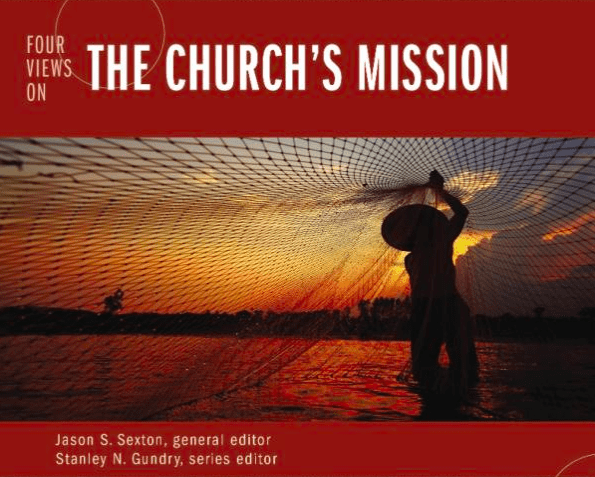 There are a multitude of debates today: church and state, attractional vs. incarnational, atonement theories, expository vs. topical, music wars, and I could go on. Getting behind these various debates may be needed, and one way to do that is to ask What is the church’s mission?
There are a multitude of debates today: church and state, attractional vs. incarnational, atonement theories, expository vs. topical, music wars, and I could go on. Getting behind these various debates may be needed, and one way to do that is to ask What is the church’s mission?
In a recent Counterpoints book Jason Sexton coordinated the debate on the church’s mission by examining four views: the soteriological, the participatory, the contextual and the sacramental theory of the church’s mission. The book is called Four Views on The Church’s Mission. The authors are Jonathan Leeman, Chris Wright, John Franke and Peter Leithart.
The editor is Jason Sexton. From Amazon: Jason S. Sexton holds the PhD from the University of St Andrews, and has taught and held visiting fellowships at the University of Cambridge, University of Southern California, UC Riverside, and UC Berkeley. His interests lay at the intersection of theology and culture, and he serves in leadership capacity with many different scholarly organizations. He has written widely in California studies, prison studies, religious studies, and contemporary theology, and is the Editor of UC Press-published, Boom California (boomcalifornia.com). For more info see http://www.jasonssexton.com.
What’s your view? Which of these is closest to yours?
Here’s a basic sketch of each view of the church’s mission:
Soteriological Mission. Represented by Jonathan Leeman from 9Marks, and closest to the view of DeYoung and Gilbert, Leeman brings layers of nuance to what he calls (although disputed) the fundamentalist perspective. Focusing largely on the mission of individual, personal conversion and redemption, he frames the discussion by highlighting what he deems a “broad mission” to be disciples or citizens of Christ s inaugurated kingdom, which is then distinct from the “narrow mission to make disciples or citizens of that same inaugurated kingdom. This all relates to church authority, including how and where the church’s mission of verbally proclaiming the gospel is carried out, and focuses its concerns on spiritual salvation and disciple-making as being of utmost importance and thus the church’s primary task in the world today.
Participatory Mission. This second view is presented by Christopher J. H. Wright. This rather comprehensive view presents the church’s mission as rooted in God’s mission, unfolding in the pages of Scripture, in the history of Israel, and in the life of the church. The church’s missional activities today, then, are participatory acts within God’s great work for his own great purpose. This view renders specific acts of verbal gospel proclamation as ultimate insofar as they are participatory, but this also includes things like creation care and love for people and God’s world, all of which amounts to participating in God’s mission to heal and reconcile his whole creation.
Contextual Mission. The next view is represented by the lead coordinator of the Gospel and Our Culture Network, John R. Franke, who places an enormous amount of focus upon the particular contextual character of Christian witness. Grounded also in the dynamic Trinitarian life, this ecumenical vision of interdependence and contextual awareness means that particular forms of faithful witness and mission will look different in different places. Diverse contexts require this contextual approach wherein God’s Spirit enables the church with power and discernment to adapt its mission to address local needs and concerns of the people where it ministers; the church in turn is shaped by these concerns. Centered upon the person and work of Christ, culturally diverse witnessing communities serve as signs, firstfruits, and instruments of God’s reign now breaking into the world and bringing healing in very specific ways.
Sacramental Mission. The last view is given by Peter Leithart of the Theopolis Institute. This view of an ecumenical-political mission is shaped by the Christian act of baptism and the Lord’s Supper, entailing a baptized believer’s sacramental life that flows into world activities as an important feature of the church’s cultural mission. The world needed fixing from its problem with the fall, which brought a strong division between garden and world, occasioning the split between communion with God and dominion on this earth as the original human mission. This sacramental life experienced by the believer and the church — this sacramental missiology—denotes an ongoing, visible, public, and political presence of the church as part of Jesus’s social agenda of restoring the broken harmony of both liturgy and life together.
The following paragraph, had it been given determinative value, would have changed this book. I applaud the recognition but it turns the book from the “church’s” mission to the “white male” vision of the church’s mission.
We also acknowledge that all contributors in this volume are white males who have lived and worked primarily in the northern transatlantic setting, and therefore are reflective of far less than half of the Protestant evangelical experience, and a shrinking one. Aside from the emerging role women are increasingly playing in the future of what the church’s mission is to look like, also missing are the significant roles that Black, Latino, and Asian evangelicals are making here, not to mention in other growing communities around the world where evangelicals of all kinds carry out vibrant apostolic ministries with a kind of power and outward expression of love that describes mission through and through, no matter what ecclesial structures may be extant. We are only learning about these movements of the Spirit to create the church in ways similar to the first-century situation, which Lesslie Newbigin says “began as the radioactive fallout from an explosion of joy,” where mission’s deepest secret is that it is acted out in doxology for the purpose that God may be glorified.











